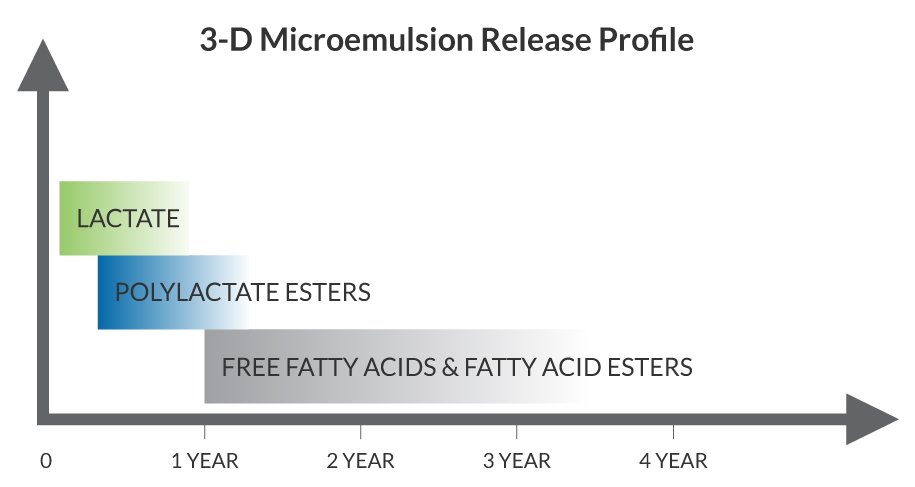A wide-area distribution, staged-release, electron donor emulsion for the optimised enhanced anaerobic biodegradation of chlorinated compounds
Benefits:
- Engineered, wide-area subsurface distribution mechanisms significantly reduce the number of injection points and events required.
- Three stage; immediate, mid-range and long-term controlled-release of lactic, organic and fatty acids for the steady production of hydrogen for optimized enhanced anaerobic biodegradation.
- High volume application optimizes contact with contaminants and reduces number of injection points required for treatment
- A viable, long-term source of staged-release hydrogen, on the order of 2-4 years from a single application
- Highly compatible with anaerobic bioaugmentation approaches using Bio-Dechlor INOCULUM PLUS
- Geochemistry and anaerobic bioremediation performance parameters are well understood and easily monitored
- Clean, low-cost, non-disruptive application (permanent wells, direct-push, excavations, etc.)
- No on-going operations and maintenance needed
- Faster and often lower cost than drawn out natural attenuation approaches
How It Works
3-D Microemulsion® is an injectable liquid material specifically designed for in situ remediation projects where the anaerobic biodegradation of chlorinated compounds through the enhanced reductive dechlorination (ERD) process is possible. ERD is the primary anaerobic biological process by which problematic chlorinated solvents such as tetrachloroethylene (PCE) and trichloroethene (TCE), dichloroethene (DCE) and vinyl chloride (VC) in groundwater are biologically transformed into less harmful end products such as ethene.
Due to its purposefully engineered structure, 3-D Microemulsion exhibits unique subsurface distribution characteristics which allow it to propagate widely within the subsurface. As a result, 3-D Microemulsion can treat a wide-areas around an individual injection point saving both time and money as it relates to the number of application points required. Building on the 3-D Microemulsion engineered molecular structure, this product is designed to provide three unique electron donor materials in a single product. This design produces a beneficial and sequential, staged-release of its three individual electron donor components (Figure 2). This results in an immediate, mid-range and long-term, controlled-release supply of organic acids to fuel the ERD process. Staged-release offers the ERD optimizing benefit of supplying just the right amount of electron donor needed for periods of up to 2-4 years on a single application. Without staged-release technology the ERD process is forced to sub-optimally speed up, then slow down or even stop in some cases. This negatively affects contaminant degradation efficiency and rates leading to longer project timelines and potentially higher volumes of commodity electron donor usage. The 3-D Microemulsion Sequential, Electron Donor Staged-Release Profile

- Stage 1 – the immediately available free lactic acid (lactate) is fermented rapidly
- Stage 2 – the controlled-release lactic acid (polylactate ester based portion) is metabolized at a more controlled rate
- Stage 3 – the free fatty acids and fatty acid esters are converted to hydrogen over a mid to long-range timeline giving 3-D Microemulsion an exceptionally long electron donor release profile
Target Contaminants:
- Chlorinated Solvents
- Tetrachloroethylene (PCE)
- Trichloroethene (TCE)
- cis-1,2 Dichloroethene (DCE)
- Vinyl chloride (VC)
- Tetrachloroethane
- Trichloroethane (TCA)
- Dichloroethane (DCA)
- Carbon tetrachloride
- Chloroethane
For a complete listing of treatable contaminants please visit our Range of Treatable Contaminants Page.
Typical Soil and Groundwater Remediation Application Methods:
- Permanent injection wells
- Direct-push injection (Barriers and Grids)
- Recirculating wells
- Soil borings
- Excavation applications into soil or on top of bedrock
- Gravity feed into bedrock wells
Next Steps:
If you currently have a project and need a remediation solution now, visit our Request a design page.
Have questions or want to explore some ideas? Contact Us to get in touch with a local representative.
FAQs about 3-D Microemulsion
3-D Microemulsion® (3DME) is an injectable liquid material specifically designed for in situ remediation projects where the anaerobic biodegradation of chlorinated compounds through the enhanced reductive dechlorination (ERD) process is possible.
3-D Microemulsion (3DME) is an injectable liquid material which aids in the anaerobic biodegradation of chlorinated compounds. This product provides three unique electron donor materials which produce a beneficial and sequential, staged-release of each individual electron donor component. 3DME exhibits unique subsurface distribution characteristics which allow it to propagate widely within the subsurface. As a result, 3DME can treat wide-areas around an individual injection point saving both time and money.
3-D Microemulsion is right for your project if you are looking for a long-term source of staged-release hydrogen to aid in the anaerobic biodegradation of chlorinated compounds.

 Americas
Americas Europe
Europe Français
Français Deutsch
Deutsch Italiano
Italiano Español
Español



